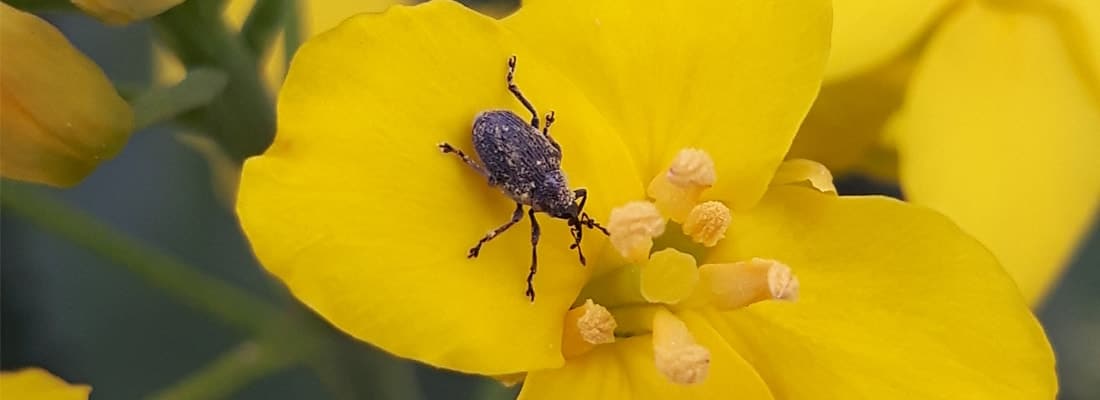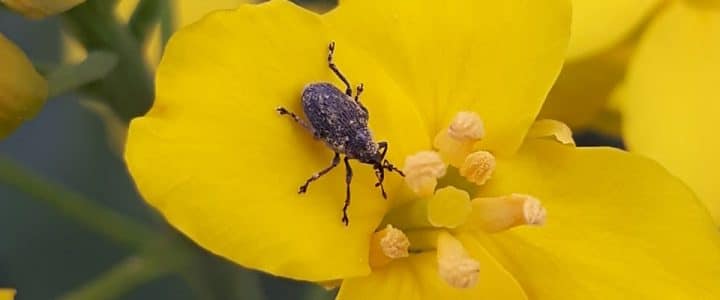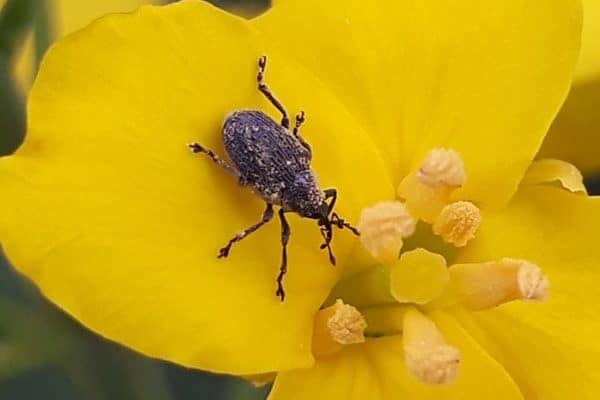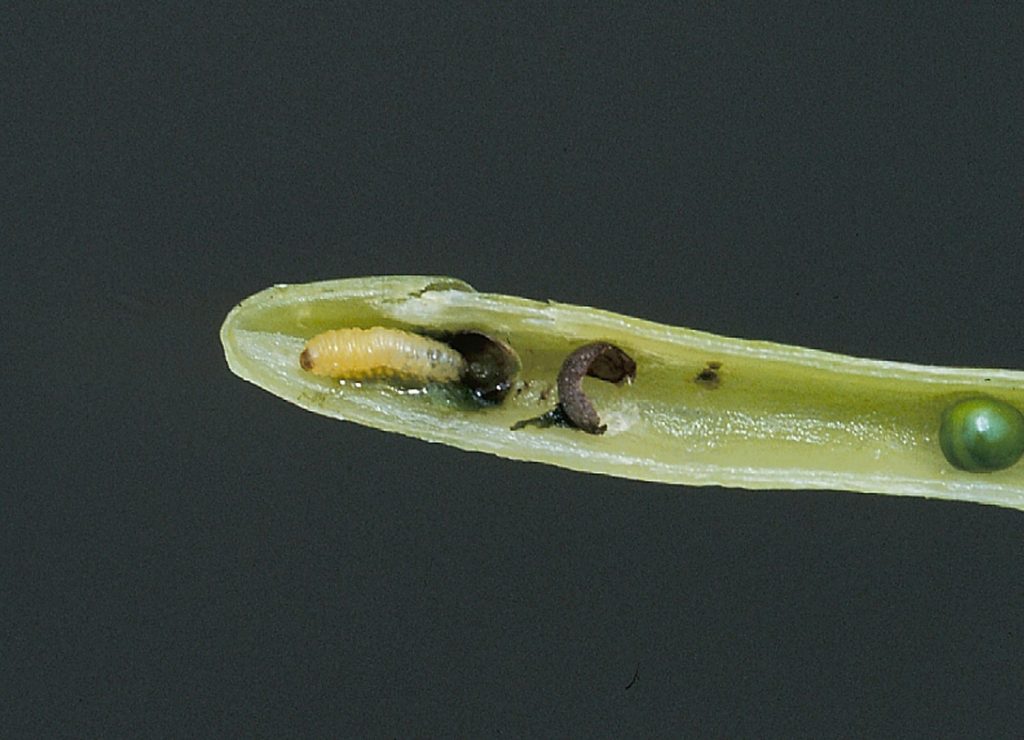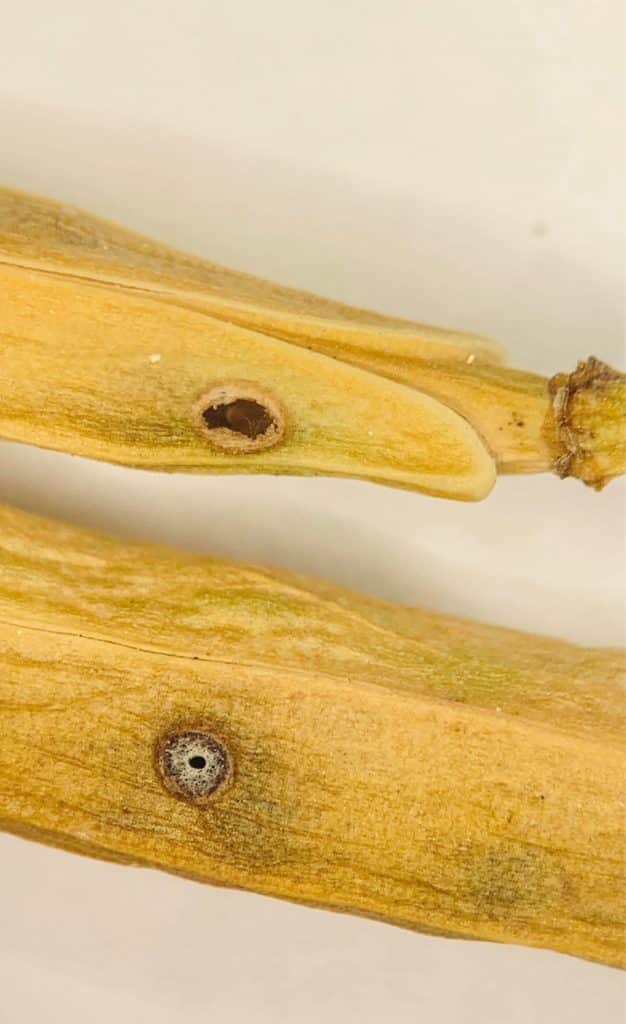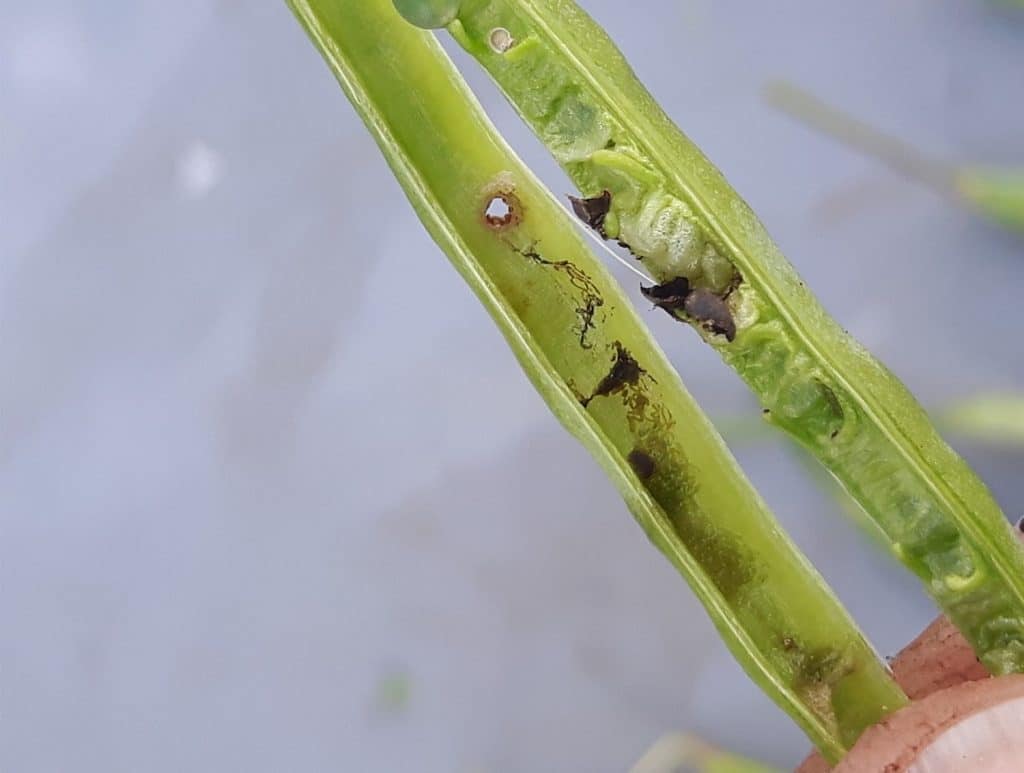This canola insect pest, which can cause considerable yield loss at the larval stage, has continued to increase its distribution in the Prairies since being found in southern Alberta. There are some natural enemies and cultural control methods to manage populations of this insect, which tends to cluster in fields that are first to flower. There are also insecticide options which can be considered once accurate scouting and economic thresholds determine that spraying may be necessary.
Important tips for best management
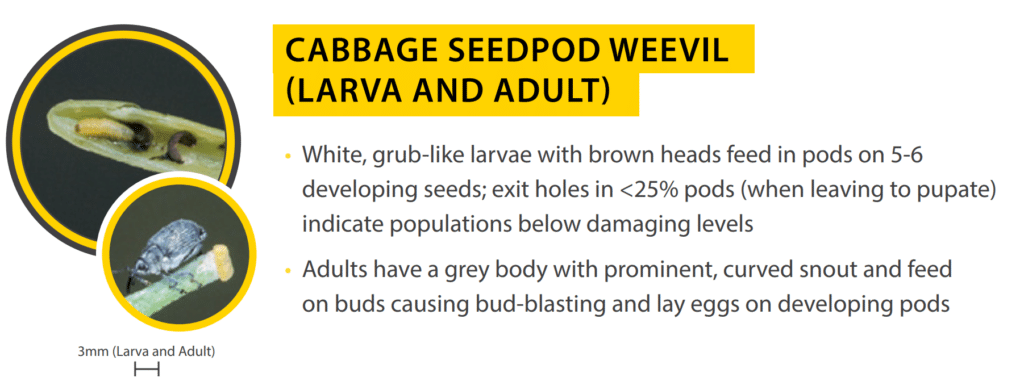
- Consider predictive cabbage seedpod weevil population maps which forecast the risk of infestation for the following summer based on adult cabbage seedpod weevil populations from the preceding summer.
- Early flowering increases the risk of infestation, as adult cabbage seedpod weevil are attracted to the first yellow canola flowers available, which indicate a suitable food source and egg laying location.
- Control alternative host plants, including brassicaceousPlants belonging to the family Brassicaceae or (previously referred to as) Cruciferae. More weeds and volunteer canola (especially if flowering early) in all crops prior to the bud stage of the canola crops
- Although adults feed on flower buds, most of the economic crop damage occurs when larvae feed within pods and destroy developing seeds.
- Scout for cabbage seedpod weevil as the canola crop begins to flower. If numbers are near threshold at this point, continue to scout through the early flowering period of the field and nearby fields.
- When scouting, select four locations within each field: two paired locations, with each pair of locations in a distinctly different portion of the field and each location (within a pair) separated by at least 50 metres. At each location count the number of weevils from ten 180 degree sweeps with a sweep net.
- For most accurate results, sweep between 11:00 am and 5:00 pm (when temperatures are above 20 degrees Celsius), when the insects will be most active.
- Use action thresholds when considering an insecticide application. The action threshold for applying insecticides is 25 to 40 weevils in 10 sweeps during canola flowering, varying slightly with canola price and cost of control.
- Insecticide application targets adults when crops are in 10 to 20 per cent flower (when 70 per cent of plants have at least three to 10 open flowers) to avoid eggs being laid in newly formed pods.
- If an insecticide application is required, spray in the morning or evening when temperatures are between 15 degrees Celsius to 24 degrees Celsius for best results and to protect pollinators. Avoid spraying under a strong temperature inversion or when temps exceed 25 degrees Celsius.
- Total parasitism by natural enemies in western Canada has usually been less than 15 per cent, but is still important for limiting weevil populations and the frequency of outbreaks.
- Consider trap cropping on large fields to reduce insecticide costs and minimize exposure of natural predators.
Overview
Background
Native to Europe, the cabbage seedpod weevil, Ceutorhynchus obstrictus (Marsham) (Coleoptera: Curculionidae), was first found in North American in southwestern British Columbia and has since spread to encompass most of continental United States, the interior of British Columbia, as well as western Canada. It was first detected on the Prairies in 1995 in canola crops near Lethbridge, Alberta and is now a major pest of Canadian canola.
For several years it remained primarily south of the TransCanada highway in Alberta, but now it continues to expand north and east into the Saskatchewan river valleys and the western edge of Manitoba. By 2016, there were potential economic infestations identified as far north as Drumheller, Alberta and Kindersley, Saskatchewan.
At least one other introduction of the cabbage seedpod weevil appears to have occurred in Québec, and the Ontario Ministry of Agriculture, Food and Rural Affairs lists it as a pest, primarily of winter and very early spring seeded canola.
The cabbage seedpod weevil completes its larval development only in certain species of Brassicaceae, although adults may feed on nectar and pollen of a wide range of brassicaceousPlants belonging to the family Brassicaceae or (previously referred to as) Cruciferae. More species.
Host plants include:
- canola
- brown mustard
- cole crops (such as cabbage, broccoli and cauliflower)
- cruciferousPlants belonging to the family Brassicaceae or (previously referred to as) Cruciferae. More weeds (such as wild mustard, flixweed and stinkweed)
Host plants are either true hosts or food hosts. Both hosts can provide food, especially pollen, for adult feeding, but only those with large seedpods that can sustain larval development are true hosts. Examples of true hosts are canola, brown mustard and wild mustard while examples of food hosts are flixweed, stinkweed and hoary cress.
Life cycle
Adult cabbage seedpod weevils overwinter in the soil beneath leaf litter in tree shelterbelts, roadside ditches and woodlots. Late in the season (September to early November) they select overwintering sites and burrow beneath the soil surface where they are protected from low temperatures.
Adult populations the preceding summer can be used to predict the risk of infestation the following year, so scouting fields each year to assess the size of the adult population has an added benefit. For the purposes of estimating next season’s threat, consider that thresholds of four to nine weevils per 25 sweeps indicate concern while 90 weevils per 25 sweeps is extremely high.
Adults emerge from their overwintering sites in spring. Peak emergence is when soil temperatures reach 15 degrees Celsius. Following their emergence, adults fly to patches of early-flowering brassicaceousPlants belonging to the family Brassicaceae or (previously referred to as) Cruciferae. More weeds, especially wild mustard (Sinapis arvensis L.) and volunteer canola (therefore it is very important to control brassicaceousPlants belonging to the family Brassicaceae or (previously referred to as) Cruciferae. More weeds- including volunteer canola).
Before canola crops enter the bud stage, adults can be found on wild mustard, flixweed, hoary cress, stinkweed and volunteer canola. When disturbed, the adults often drop to the ground and play dead. After several seconds they resume activity.
Adults usually invade canola crops in June, during the bud to early flowering stages, and feed on canola pollen, nectar, buds and racemes. Significant clustering of adults along field edges in early stages of invasion is followed by more uniform distributions as canola development proceeds to flowering and pod enlargement.
Mating occurs on canola plants and ovariole development requires that females feed on raceme tissue of the crop or volunteers. Most eggs are laid soon after flowering, when pods are still developing. During egg laying a female makes an opening in the pod wall with her mouthparts, and then turns to deposit an egg into the opening. The female then brushes her abdomen over the area, releasing a pheromone that deters other females from laying eggs in the same pod.
Eggs are very small, oval and opaque white. Usually only a single egg is deposited per pod. However, two or more eggs can be laid per pod during outbreaks. Eggs hatch in about six or seven days. Females continue to lay eggs until they die later in the season.
Larvae develop rapidly in spring canola, progressing through three larval instars in approximately 50 days in southern Alberta. During this time, each larva consumes five to six canola seeds. When mature, the larva chews an opening in the pod wall, drops to the soil, burrows in, and pupates in an earthen cell. Adults emerge approximately 14 days later. There is one generation per year.
Influence of environment
Overwintering survival significantly declines as temperature decreases from five degrees Celsius to minus five degrees Celsius. The supercooling point where the insect can no longer stop from freezing is minus seven degrees Celsius. Longer overwintering periods have much less effect on mortality.
Peak spring emergence of the adults is when soil temperatures reach 15 degrees Celsius.
Flight dispersal by weevil adults is dependent on temperature and relative humidity. The mean temperature required for a flight height of one metre is 12 degrees Celsius, and flight height increases with temperature. However, increases in relative humidity are associated with reduced flight heights and dispersal distances. As a result, cold, wet springs can result in lower cabbage seedpod weevil infestations.
The distribution and abundance of the cabbage seedpod weevil have been monitored yearly in western Canada since 1997. Predictive models based largely on climate data indicate that this pest will eventually disperse to all regions of canola production in western Canada, including the Peace River region.
To help monitor the spread of cabbage seedpod weevil, real-time and annual summary distribution maps are available in Alberta and other agricultural departments, as well as on the Prairie Pest Monitoring Network.
Cabbage seedpod weevil research
Some canola agronomic research projects on cabbage seedpod weevils include:
- Biology and control of the cabbage seedpod weevil, a new pest of canola in Alberta
- Integrated management of the cabbage seedpod weevil and overwintering biology of canola pests
- Management of lygus bugs and cabbage seedpod weevils in canola
- Management of lygus bugs and seedpod weevil in canola at the farm level
- Detection, surveillance and management of weed, insect and disease pests that threaten the economic viability of crop production and the environmental health of Prairie agro-ecosystems
- Validation of lygus and other insect pest thresholds in commercial farms throughout the Prairie Provinces
Identification
Adult weevils are ash-grey and approximately three to four millimetres (0.1 to 0.2 of an inch) long. They have a prominent curved snout that is typical of most weevils.
Scouting techniques
Adult populations the preceding fall can be used to predict the risk of infestation. High numbers of weevil adults in the fall will likely mean significant infestation levels in the following spring, although a severely cold winter with little snow cover could reduce the survival of overwintering adults.
Research has determined that when more than 25 per cent of pods are damaged by cabbage seedpod weevil larvae at crop drydown yield reduction has occurred and insecticidal control was warranted. If less than one in four pods show exit holes (at plant maturity) cabbage seedpod weevil numbers likely remained below thresholds or insecticide control was successful in reducing numbers to below damaging levels.
Scouting for cabbage seedpod weevil should start when the crop first enters the bud stage, and it should continue through the flowering period. Sweep between 11:00 am and 5:00 pm (when temps are above 20 degrees Celsius) and when winds are calm. The insects will be most active and sweep counts will be more accurate. Sample both the perimeter and interior of the field as they begin to flower to obtain an accurate estimate of weevil numbers throughout the field.
Sweep at four locations within each field, where selected as locations within each pair located 50 metres or more apart and each set of paired locations should be in distinctly separate parts of the field. At each location count the number of weevils from ten 180 degree sweeps with a sweep net. Previously 10 locations within each field were recommended, however recent data 1 suggests that four locations as previously described provides a similar assessment of insect levels (this was the case for more than 90 per cent of fields studied). However, infestations may be concentrated on field margins or flowering areas as insects move into the field.
A few other weevil species may also be found in canola but do not require control measures, so differentiating between these species is necessary. The most common of the closely related weevil species is Ceutorhynchus neglectus, which is about half the size of the cabbage seedpod weevil. It will feed on canola but prefers flixweed.
Economic thresholds
The economic thresholdAn economic threshold is the level of infestation (ex. pest insect density) at which lost yield (ex. due to feeding/insect pest damage) exceeds the cost of the chemical and its application. More for applying insecticides is currently 25 to 40 weevils in 10 sweeps 1 during canola flowering, to allow for significant changes in canola price or insecticide application costs. The higher end of the range should be used when beneficial insects and bio control agents are present (ex. use close to 40 weevils rather than 25 weevils in 10 sweeps during canola flowering, when beneficial insects and bio control agents are present).
Crop damage
Canola in the pre-bolting to early flowering stage can compensate for adult weevil feeding on buds and stems. The majority of crop damage occurs when larvae feed within pods and destroy developing seeds. Each larva consumes about five seeds during its development. Although this amount represents only 15 to 20 per cent of the total yield of a particular pod, these pods are also predisposed to premature shattering.
Canola pods harbouring cabbage seedpod weevil larvae may appear distorted. When larvae consume some seeds within pods, the undamaged seeds enlarge and mature, often leaving misshapen pods.
Larvae emerge from pods via exit holes. Pods with exit holes shatter before harvest more frequently than non-infested pods, and exit holes may serve as entry points for fungal spores that can germinate to further reduce yield.
Overwintered adults feeding on developing canola buds can also cause bud-blasting and reduced yield potential in dry years when the ability of plants to compensate is limited.
In addition, when the new generation of adults emerges in late summer, weevils can feed through the pod walls in late-maturing fields to consume canola seeds, reducing yield and quality.
In southern Alberta and Saskatchewan, the cabbage seedpod weevil often occurs along with lygus bugs (Lygus spp.) (Hemiptera: Miridae), which are intermittent pests of canola.
A four-year research study assessing the impact of cabbage seedpod weevil control on lygus bugs found that spraying for weevils at the early flower stage (earlier than the optimum stage for lygus), could reduce lygus abundance. Fields flowering early enough to require control for cabbage seedpod weevil however, were not fields that later experienced high lygus infestation. Therefore growers should continue to scout and manage cabbage seedpod weevil and lygus bug separately 1.
Management
Natural enemies and biological control
Extensive sampling of canola fields in southern Alberta and Saskatchewan from 2001 to 2006 revealed a total of 15 parasitoid species attacking the weevil, representing five families of HymenopteraThe insect order (the scientific classification more broad than Family) which includes sawflies, wasps, bees, and ants. More.
The dominant natural enemy fauna of cabbage seedpod weevil in the Prairies is comprised of 14 species of larval ectoparasitoids with more than 90 per cent of all parasitism inflicted by the pteromalids (parasitic wasps) Trichomalus lucidus (Walker), Chlorocytus sp., and Pteromalus sp., and the eulophid Necremnus tidius (Walker). Small numbers of adult weevils are parasitized by Microctonus melanopus (Ruthe), a braconid wasp found in southern Alberta.
Parasitism of cabbage seedpod weevil larvae increased from 0.1 per cent in 2002 to 5.0 per cent in 2004, and increased further from 2004 to 2005. However, total parasitism was usually less than 15 per cent. These parasitism levels are considerably lower than those common in Europe, where rates can reach 50 to 90 per cent and reflect that the parasitoid fauna did not coevolve with the weevil, but instead is comprised of native species that expanded their host ranges to exploit abundant cabbage seedpod weevil larvae in canola fields.
Researchers investigated a classical biological control program for cabbage seedpod weevil control. In British Columbia, three European parasitoids were released in 1949, but recent surveys found only one species established, Stenomalina gracilis (Walker), and unfortunately this species is non-specific in the range of weevil hosts it attacks.
Researchers must also consider compatibility between weed and insect pest biocontrol. A number of weevil species in the subfamily Ceutorhynchinae have been released in North America for the biological control of various weed species, or are under evaluation for release. Parasitoids selected for release to control cabbage seedpod weevil should not also attack these beneficial weevils. The Feasibility of using Trichomalus perfectus for biological control of cabbage seedpod weevil in the Prairies research project is currently underway through the Canola AgriScience Cluster.
Foundational research on cabbage seedpod weevils in Canada is summarized in this Research Hub blog.
Field management (cultural control)
Trap cropping
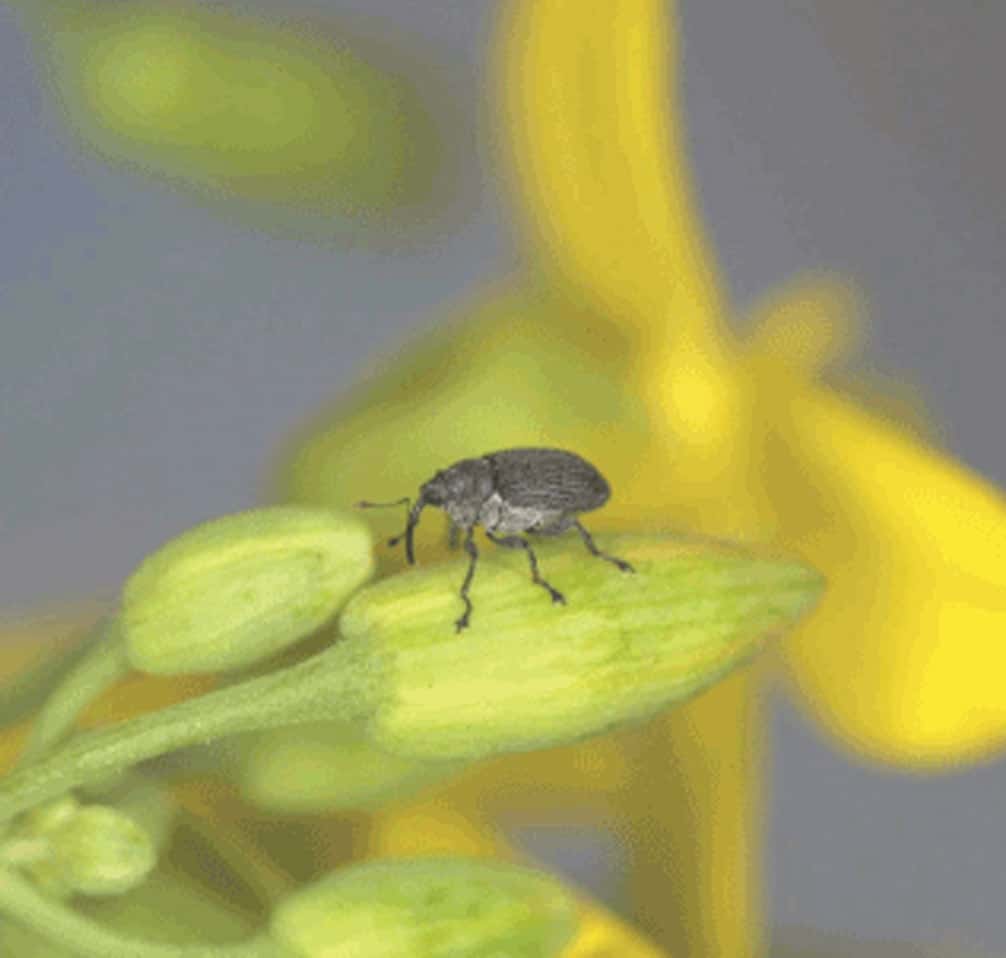
At present, trap cropping has not been adopted, but it has shown promise as a cultural strategy for controlling the cabbage seedpod weevil. This approach takes advantage of the weevil concentration that often occurs at field edges (perimeter of field) when weevils first invade a canola field.
Trap crops were investigated for control of cabbage seedpod weevil in southern Alberta from 2001 to 2004 using large commercial fields with a main crop of B. napusAlso referred to as Argentine canola, it is the species of canola currently commonly grown in Canada. More and the perimeter planted at the same time to a B. rapaAlso referred to as Polish canola, it is the less commonly grown species of canola currently grown in Canada. More cultivar. B. rapaAlso referred to as Polish canola, it is the less commonly grown species of canola currently grown in Canada. More flowered about one week earlier than the main crop of B. napusAlso referred to as Argentine canola, it is the species of canola currently commonly grown in Canada. More and effectively concentrated weevils where they could be controlled with a pyrethroid insecticide to prevent their movement into the main crop.
While planting the perimeter with B. rapaAlso referred to as Polish canola, it is the less commonly grown species of canola currently grown in Canada. More and the main crop with B. napusAlso referred to as Argentine canola, it is the species of canola currently commonly grown in Canada. More is one way to achieve this, another alternative is to plant a strip of the same varietyA variety is a variant of a species that evolved in nature without the intervention of humans, e.g. Brassica oleracea variety (in short form, var.) botrytis (cauliflower), var. capitata (cabbage), var. italica (broccoli), etc. More seven to 10 days before the rest of the field (which can also serve as a trap for adult weevils). This has worked well in large square fields (1.6 by 1.6 kilometres or about one mile by one mile) even when weevil populations were high. However this approach was not as effective when fields were smaller and narrow, especially when weevil densities far exceeded the economic thresholdAn economic threshold is the level of infestation (ex. pest insect density) at which lost yield (ex. due to feeding/insect pest damage) exceeds the cost of the chemical and its application. More.
The advantages of trap cropping can include substantial savings in costs of insecticide and fuel from reduced spraying applications, and the method has the potential to conserve populations of natural enemies and other beneficial insects in the main crop area (which may comprise up to 90 per cent of the field). A requirement for successful implementation of a trap crop strategy is to carefully monitor the trap crop so that insecticide can be applied before beetles disperse in large numbers to the main crop.
Seeding date
Seeding later in spring, at recommended seeding rates, can help reduce weevil infestations and damage. Early seeding of canola (in late April in the southern Prairies) can put canola crops at risk of higher infestation levels of the weevil than for crops seeded later (in early May) because early-seeded crops can be especially attractive to invading weevils. Cabbage seedpod weevils are more likely to infest the earlier flowering crops. First flowering canola crops in an area should be monitored most carefully as it is characteristic of the cabbage seedpod weevil to identify yellow flowers as a marking for a food source and egg-laying location and to migrate there.
Delaying seeding, must be balanced with the agronomic advantages of early seeding, such as higher levels of residual soil moisture from snow melt, avoiding summer heat waves, and damage from early fall frost.
Soil fertility
Weevils tend to cluster in fields where sulfur content is high in plant tissue because females prefer to feed and lay eggs on plants with high levels of sulfur and low levels of nitrogen. Sulfur fertilization can result in increases in sulfur-containing glucosinolate compounds in plant tissue, and the breakdown products of these compounds are attractive to adult weevils. Larval development time increases with increasing nitrogen levels. Therefore using a balanced fertility program (especially regarding nitrogen and sulphur, when considering the impact on cabbage seedpod weevils) is required (in addition to the benefit of healthy crops being more resistant to any stressors, including insect feeding or damage).
Resistance breeding
Not all species of Brassicaceae are equally susceptible to infestation by the cabbage seedpod weevil. For instance, B. rapaAlso referred to as Polish canola, it is the less commonly grown species of canola currently grown in Canada. More is more susceptible than B. napusAlso referred to as Argentine canola, it is the species of canola currently commonly grown in Canada. More and susceptibility of Brassica junceaAlso referred to as brown mustard, it is a minor crop (from the Cruciferae or Brassicaceae plant family, commonly known as the mustard family) grown in Canada. More (L.) Czern. (brown mustard) is approximately equivalent to B. napusAlso referred to as Argentine canola, it is the species of canola currently commonly grown in Canada. More. Yellow mustard Sinapis alba is resistant to the weevil, and this resistance has provided the foundation for research to develop weevil-resistant canola. Researchers have developed resistant germplasm based on Sinapis alba L. (yellow mustard) crosses with B. napusAlso referred to as Argentine canola, it is the species of canola currently commonly grown in Canada. More. The resistant germplasm expressed both antibiotic and antixenotic resistance to the weevil:
- Weevils preferred not to feed or oviposit on the resistant lines, and when they did, larval development times were longer and larval biomass was less.
- Overwintered females that fed upon the resistant germplasm had reduced egg development.
However, this resistance has yet to be commercially developed.
Insecticide control options
Do not spray too soon, as the weevil will typically continue to invade for at least a week to 10 days beyond the opening of the first flowers, damage does not occur until pods are large enough for egg laying.
Insecticide applications target adults when crops are in 10 to 20 per cent flower (when 70 per cent of plants have at least three to 10 open flowers) to avoid eggs being laid in newly formed pods. Applying insecticides prior to full bloom ensures that fewer pollinators will be around the plants when they are sprayed.
Spraying at this stage will allow the weevils more time to move into the field, but at the same time it is still early enough to keep them from laying a significant number of eggs in newly forming pods. Spraying after this stage when populations are at or above threshold may result in yield loss and will also impact beneficial insects, including pollinators, which have moved into the field.
Keep in mind that canola can compensate for weevil feeding on buds and stems. Adequate moisture should allow the plants to compensate for bud feeding that may take place prior to flowering.
Spray in the morning or evening at temperatures of 15 to 24 degrees Celsius for best results and to protect pollinators. Do not spray under a strong temperature inversion or when temperatures exceed 25 degrees Celsius.
When an application is necessary, only use insecticides registered for control of cabbage seedpod weevil in canola and always read and follow current product label directions. Provincial crop protection guides are a great source of information for this:
- Alberta Crop Protection Guide (The Blue Book)
- Saskatchewan Guide to Crop Protection
- Manitoba Guide to Field Crop Protection
Table 1. Insecticide products registered for control of cabbage seedpod weevil in canola
* Provincial crop protection guides restricts growers from more than one application for cabbage seedpod weevil per season by either ground or aerial application.
** LD50 values represent the relative toxicity of a pesticide. They represent the dose (in mg/kg body weight) that will kill 50% of the test animals. Thus the lower the number the greater the toxicity. Values given are for oral LD50.
***Talk to your grain buyer prior to application
Note- Always check your provincial crop protection guide for current listings of registered control products.
Source: Alberta Crop Protection Guide 2023 (The Blue Book)
For more scouting and control tips on cabbage seedpod weevil, see the Canola Watch fundamentals article.
Footnotes
- Cárcamo, H., Meers, S., & Herle, C. 2019. Managing cabbage seedpod weevils (Coleoptera: Curculionidae) in canola (Brassicaceae) – are Lygus (Hemiptera: Miridae) affected? The Canadian Entomologist, 151(1), 85-93. https://doi.org/10.4039/tce.2018.57
